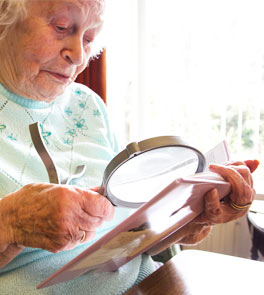
Macular degeneration is a common condition in older adults and the leading cause of vision loss and blindness in people over the age of 65. Macular degeneration is also known as age-related macular degeneration (AMD).
Macular degeneration affects the macula, the part of the retina responsible for the crisp, detailed vision needed for reading or driving. As we age, the tissue in the eye responsible for central vision slowly begins to deteriorate which can significantly affect a patient's quality of life.
Macular degeneration can be classified as either wet or dry. Dry macular degeneration is the more common diagnosis.
Symptoms often associated with macular degeneration include:
- A gradual loss of ability to see objects clearly
- A gradual loss of color vision
- Distorted vision
- A dark or empty area appearing in the center of vision
Your lifestyle can play a role in reducing your risk of developing AMD. This includes:
- Eating a healthy diet high in green, leafy vegetables and fish
- Not smoking
- Maintaining blood pressure and weight at normal levels
- Engaging in regular, moderate exercise
Dry Age-Related Macular Degeneration
AMD is a progressive disease of the retina, the part of the eye that detects visual signals and sends them to the brain. It is the leading cause of vision loss in people over 65. There are two forms of AMD:
- The dry form accounts for 85 to 90% of AMD cases
- The wet form accounts for 10 to 15% of AMD cases
At Tulsa Retina Consultants, we are now offering Valeda treatments for dry AMD.

How Valeda Works
Valeda uses photobiomodulation (PBM), specific wavelengths of low-level light therapy, to stimulate energy production within the eye, resulting in improved cellular health. Healthy retinal cells are essential for maintaining good vision.
Benefits of Valeda
Treatment with Valeda can help you see more clearly now and in the future. Retinal imaging indicates improvement in eye scans when assessed for drusen (protein deposits observed in eyes with dry AMD.
Valeda Safety
There have been no treatment-related side effects in clinical trials with Valeda.
Valeda is authorized by the U.S. Food & Drug Administration (FDA) and is available by prescription only.
What to Expect
Before Treatment
No special preparation is needed before treatment. You will need to remove glasses or contact lenses. There are no eye drops, drugs, or needles used in the treatment. There is no discomfort during or after the treatment.
During Treatment
You will be seated comfortably in front of the Valeda and guided through each step of the treatment. The active treatment time is less than 5 minutes per eye per session.
You will receive 9 treatments over 3 to 5 weeks during each series. Typically, a series is repeated every 4 months. Your doctor will determine your plan.
After Treatment
Due to the exposure to bright lights, you may experience an afterimage following treatment. This is known as photostress. Normal photostress recovery time is approximately 15-30 seconds. Following treatment, you will be able to resume normal activities.
*If you have any known photosensitivity to yellow light, red light, or near-infrared radiation (NIR), or if you have a history of light-activated central nervous system disorders (e.g., epilepsy, migraines). In addition, patients should not receive treatment within 30 days of using photosensitizing agents (e.g., topicals, injectables) that are affected by 590, 660, and/or 850 nm light before consulting with their physician.
To better understand what Valeda can do for you, please read about the LightSite III Pivotal 24 Month Study (click to read).